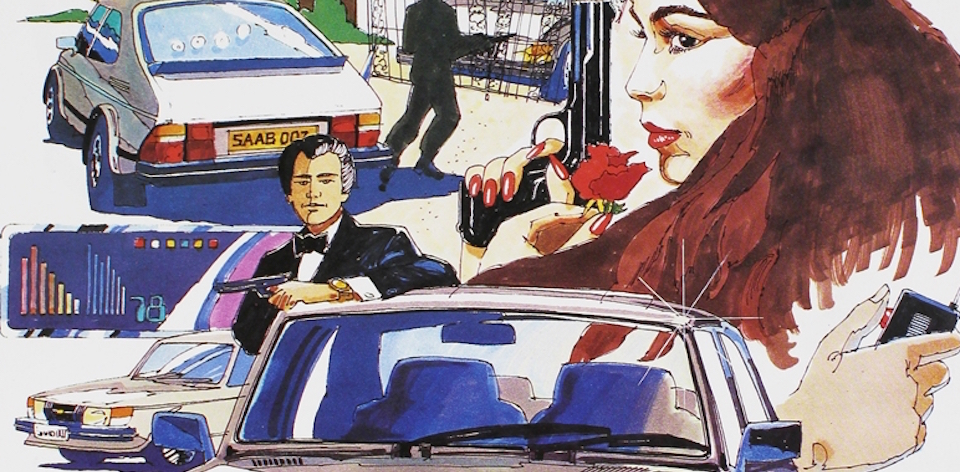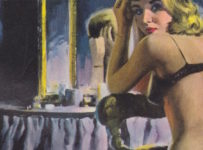Bond. James Bond. Is there a name more synonymous with spying, tuxedos, and shaken cocktails than the British secret agent? Join me as I read all of the James Bond books in 007 Case Files, encompassing Ian Fleming and beyond. For Your Eyes Only: there’s potential spoilers ahead.
“James Bond changed down into third gear, drifted the Saab 900 Turbo into a tight left-hand turn, clinging to the grass verge, then put on a fraction more power to bring the car out of the bend.” Following a brief cold open, this is how John Gardner reintroduces 007 for the tastes of the 1980s.
Gardner’s approach in the 1981 release is of the back-to-basics variety, attempting to steer Bond away from the gadget-heavy reputation he’d earned through almost two decades of books and films. The plot is simplicity itself. The “00” section has been effectively retired, with a number of “political restraints placed on the Secret Service.” Bond is kept on staff for the kind of black ops missions he excels at (or a “blunt instrument” as M reminds us). He is sent to investigate Dr. Anton Murik, a nuclear physicist with suspected ties to terrorism.
Yet for many commentators at the time, including Colonel Sun author Kingsley Amis, Gardner’s approach was simply too “tame.” For perspective, this was the first “proper” standalone Bond novel since Amis’ 1968 book, the non-canonical John Pearson “biography” and Christopher Wood’s novelisations notwithstanding. Perhaps Gardner’s straightforward narrative jarred at the point where cinematic expectation met Fleming fidelity. Or was it that the idea of Bond was bigger than any one approach?
“There are moments when this country needs a troubleshooter – a blunt instrument – and by heaven it’s going to have one.“
From the start, Gardner intentionally takes a bare bones approach. In his brief acknowledgements section/foreword, Gardner states: “I would like to point out to any unbelievers that all the ‘hardware’ used by Mr. Bond in this story is genuine.” Or at least genuine for the early 80s. (Does that included the vaguely referenced “sophisticated” J-200 Detectorscope, Mr. Gardner?) This at least reflects the original intent of Fleming’s novels: Casino Royale was less prose than reportage, although even Fleming got more dramatic as the years went by.
Gardner explains the accuracy of Bond’s gadgets while sitting in a SAAB 900. The auto manufacturer heavily cross-promoted the book across print and television.
Bond himself has morphed to fit the model of an ’80s gentleman. Cutting back on the smokes (with a new special low-tar blend from Morland of Grosvenor Street, of course) and liquor (nary a martini to be seen), this is a Bond who is seen to be doing exercise. Lest we forget that it was in Thunderball that his hedonistic lifestyle saw him wind up in a health spa. (Gardner chronicled his own battles with alcoholism in his debut, Spin the Bottle). Gardner peppers his Bond with little character ticks: he’s a “staunch monarchist”, loves M like a father but still isn’t averse to a bit of flippant casual homophobia/transphobia.
Which is where I feel that many of Gardner’s critics have got it wrong. Labelled both “crass” and “tame” in the same breath, Gardner’s updated Bond doesn’t treat him (as Judi Dench’s M would later put it in the Goldeneye film) as just a “sexist, misogynist dinosaur, a relic of the Cold War.” This is a Bond who has incrementally evolved over the years, or at least mellowed a bit. Contemporaneous reviews in The Globe and Mail and the Library Journal both unfavourably compared Bond girl Lavender Peacock with Pussy Galore in a kind of pre-Twitter fan entitlement outrage.
That said, Gardner’s adversaries and lovers for Bond are also lifted directly from the Fleming mould. Murik is a classic evil genius, one who finds it more logical to send multiple nuclear power plants into meltdown than simply promote his own ‘cleaner’ methods. He even comes with a racially stereotyped henchman: Caber, a wrestler type with a Scottish brogue who doesn’t take too kindly to Bond beating him. If criticism can be labelled at Lavender Peacock, it’s that she’s more of a damsel in distress than would be expected for 1981.
What LICENCE RENEWED offers more than anything is a collection of solid set pieces. Gardner was already an established thriller writer with the Boysie Oakes series, and his tight action writing is fluid and highly readable. There’s at least two memorable pieces here. The first is a car chase that’s an absolute page-turner, culminating in Bond’s capture. The big finale is a gripper aboard a plane, the kind of high-stakes moment we’ve seen in a score of films by now but is used here for the same reason any formula gets trotted out: it works.
The no-frills approach coupled with the heightened sense of violence foreshadows the shift the films would make in The Living Daylights (1987) and Licence to Kill (1989) starring Timothy Dalton. Before that, A View to a Kill (1985) would see Roger Moore’s character visit a racetrack like the sequence at Ascot Racecourse at the start of this book, although it’s unknown if Gardner was an influence on screenwriters Michael G. Wilson and Richard Maibaum. More broadly, the nuclear plot skirts the edges of an environmental concern that followed the 1979 Three Mile Island accident, and pre-empted the ones in Chernobyl (1986) and Fukushima (2011) by several years. Indeed, the working title of the book was simply Meltdown.
LICENCE RENEWED may not have the punch some were expecting for a Bond book, but it’s a solid restatement of 007’s core traits – and certainly an improvement on the last handful of Fleming books. You may not think so from this singular outing, but Gardner would still go on to write a total of 16 books, including novelisations for Licence to Kill and Goldeneye, over a span of 25 years. If you’ve exhausted all the Fleming books and are yearning for the 80s, this is a good place to start.
James Bond will return…in For Special Services.






